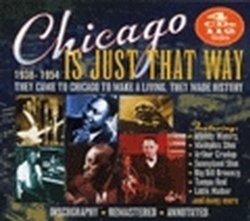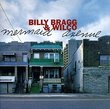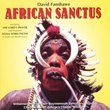| All Artists: Various Artists Title: Chicago Is Just That Way: 1938-1954 Members Wishing: 0 Total Copies: 0 Label: Jsp Records Release Date: 4/19/2005 Album Type: Box set, Original recording remastered Genres: Blues, Jazz, Pop, Rock Style: Soft Rock Number of Discs: 4 SwapaCD Credits: 4 UPC: 788065774424 |
Search - Various Artists :: Chicago Is Just That Way: 1938-1954
 | Various Artists Chicago Is Just That Way: 1938-1954 Genres: Blues, Jazz, Pop, Rock
|
Larger Image |
CD DetailsSimilarly Requested CDs
|
CD ReviewsChicago Is Just That Way Stuart Jefferson | San Diego,Ca | 06/23/2008 (5 out of 5 stars) "Four discs. 80,79,77,77 min. each approximately. Remastered sound. This set concerns itself with the changing sound of the blues as it moved to the big city,in this case,Chicago. Besides the well-known artists here,there were a number of others who helped usher in the more sophisticated,electrified sound of music after the war.
The first disc are tracks with the great Tampa Red,vocalist and very fine guitarist in the "Hawaiian-style"(slide guitar)that was popular long before the blues moved to the city. The rhythm section is comprised of the well-known duo of Odie Payne-drums and Ransom Knowling-bass. The piano player Johnny Jones is heard on a number of tracks and his contributions are a fine addition. Also,there is a tenor sax on quite a few sides that help give the arrangements a less country-feel. The chronology on this disc begins in 1949 and continues into the early fifties. On the last few tracks Sonny Boy Williamson and Walter Horton play harmonica,though not as a duo. A look at the titles will show a number of familiar songs mixed with some not as well-known. However the sound is seamless no matter what title is being played. The second disc covers 1945 through 1947,and has a number of well-known people. Johnny Shines,Memphis Slim,Muddy Waters,and others make appearrances,and this is where the blues form really begins to transform itself from acoustic to electrfied city blues. Arthur Crudup performs one of the most well-known tracks here(That's All Right)in a trio format which is very effective. But like the entire set,it doesn't matter the title-it's the style that's important. The third disc starts in 1947 and continues into 1949. With tracks by people like Sunnyland Slim,the great mandolinist Johnny Young,Big Bill Broonzy,and the relatively unknown Eddie Boyd-a fine singer/piano player,the quality of the music doesn't let up. Among the backing players are the likes of Muddy Waters and Little Walter,who keep things authentic. The final disc follows the time period of 1949 through 1951. This disc,perhaps more than the others,shows how far blues had come from the dusty towns in agricultural areas to the slicker,faster moving,large industialized cities. Jazz Gillum,a vocalist/harmonica player epitomizes this shift with a style and feel of "city sophistication". Others like Jimmy Rodgers(Ludella)and Robert Lockwood(Dusy My Broom)continued transforming the blues into what a lot of people consider the most popular style of music,that came out of the migration from the South. Music that was,and still is,very powerful in it's sound and feeling. This set goes a long way in explaining how the blues was transformed,not only by a few well-known artists,but by a number of lesser known but important people,who found in the big city,a new life and a new way to express themselves in music. This set belongs in every blues lovers shelf-not only for completeness,but for the quality of the music,which still lives and breathes today." |

 Track Listings (28) - Disc #1
Track Listings (28) - Disc #1
